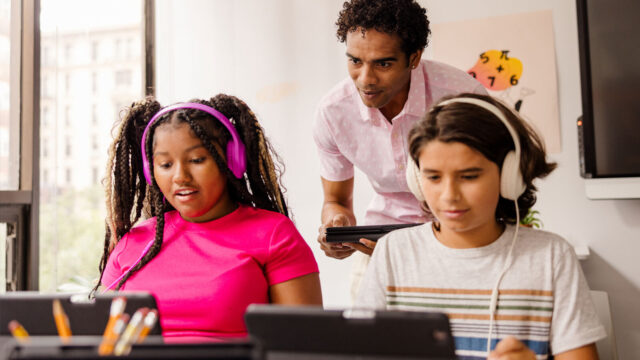
Imagine students are sitting in a classroom, and all the teacher does is stand in front of a whiteboard, project notes, and read them verbatim. There is of course a time and place for instruction like this, but plenty of students might find themselves bored out of their minds.
Classroom education doesn’t have to look like this! Game-based learning in the classroom helps to engage students by directly involving them in the learning process. The result? Improved retention of material, increased student engagement, and an overall enjoyable learning environment.
Let’s take a look at how to successfully use game-based learning and gamification in the classroom.
What is gamification vs. game-based learning?
While game-based learning is leveraging games to teach and deepen understanding of curriculum, gamification focuses on applying the principles of games to non-game situations, such as teaching in a classroom.
Gamification in education involves both extrinsic and intrinsic motivations that work to encourage academics, behavior, and non-cognitive skills, including collaboration and engagement.
What are the benefits of game-based learning?
1. Improved recall and retention
Attitude plays an important role in how well students are able to recall the material they learn. Higher beliefs in one’s ability leads to higher achievement, which in turn improves one’s beliefs—a virtuous cycle! If your instruction depends solely on students reading 40 pages a week from a textbook, reviewing presentation slides, and then studying flashcards, they’re going to quickly forget everything they “learn”—and be desperate to learn something more interesting. Classroom games can encourage creative thinking and problem-solving. They can even help students recall information better when the game takes concepts they learn and brings them to life.
Let’s say you’re teaching a history class and have assigned your students to read a chapter from a textbook on the forms of government (for many students: yawn). Reading and note-taking are certainly important skills for students to practice, but those alone won’t guarantee they’ll remember everything come exam day, let alone beyond your class.
A better approach? Take a cue from roleplaying games. Combine readings and traditional lecturing with interactive classroom roleplaying to help cement the material. For example, you could split your students up into different groups of governments (democracy, monarchy, dictatorship, etc.) and present them with a relevant social issue. Then, ask them to draw from their readings to create a short enactment of how their type of government would respond to that issue. Students could even debate the merits and drawbacks of each type of government. This kind of memorable and engaging experience will stick with students well beyond your class.
2. Development of problem-solving skills
Another benefit of game-based learning is that is that it can help to develop essential problem-solving skills. For children and teens, this is an especially important skill to learn early on, as it’ll serve them well into adulthood.
Maybe you’re teaching 2-D and 3-D shapes. You could walk through static images of shapes and calculations, but similar to a reading about government, many students won’t feel engaged. As an alternative, you could consider how geometry problems are presented in complex, immersive video games. For younger students, point out circles, squares, and cubes in the games they play. More advanced students can analyze how 2-D and 3-D objects in a game can be broken down into points, lines, and basic shapes. Incorporate real-world problem solving or labs into your classroom by giving students actual physical objects and gaming environments to interact with. You’d still teach the same topics, but with more emphasis on practicality.
Regardless of what you’re teaching, the key is to get students thinking and answering questions, not just reading and memorizing. There are tons of ways you can make your class’s material relevant to the real world. Get creative!
3. Instant feedback
How do you measure whether students understood their readings or your lectures? You could quiz them the old-fashioned way, but some students experience test anxiety or otherwise have a hard time with typical multiple-choice assessments. Classroom games not only improve student engagement but also give you instant, valuable feedback on how well students are really doing. In part this is because games are often designed to provide instant feedback. Make a wrong move, and the level ends! In addition, games often have a social component; they can open up some of the shyer students and get everyone involved.
How to choose the right games for your classroom
The games you choose to include in your lessons need to align with your teaching goals. Generally, you should consider the following characteristics of effective classroom games:
- Ease of use: Students shouldn’t have to sift through manuals and online tutorials to figure out what you’re trying to get them to do. Look for classroom games that are simple and to the point. Even simple games have the potential to be sufficiently challenging so class time isn’t wasted on learning complicated rules.
- Engagement: If it’s a new class and you don’t know your students too well, consider distributing a survey at the beginning of a unit to determine what type of activity your students would like to do. Whatever game you settle on needs to actually be enjoyable for your students.
- Customization: Agency is so important to get students caring about their learning. Look for ways for students to create avatars, outfits, and other game elements. The best classroom games allow students to learn the material while giving them the creative freedom to express themselves in their own unique ways.
- Purpose: For a classroom game to be engaging, it should have meaningful and tangible goals for students. In other words, you don’t want to give your students games just for the sake of entertaining them—the games you settle on should combine fun with deliberate and well-designed lesson plans.
When incorporating games into the classroom, you may want to consider some combination of educational video games, roleplaying group activities, or smaller gamification elements to engage students in the material they’re learning. Shaped is filled with ideas to help you out, such as the articles featured below.

Try these fun 3rd grade math games and activities in your classroom! These 8 games, activities, and puzzles will help your students love learning math and see how 3rd grade math ideas show up in the real world.

In this hands-on “Guess My Number Math Game” activity for students in kindergarten and up, students can thrill and awe their peers with a mathematical magic trick.

Explore 6 fun math activities for middle school from HMH's GO Math! program. These middle school math games and projects for grades 6-8 will keep your students engaged.

These math icebreakers are games and activities that span all grades to help math teachers get students practicing math while getting to know one another.

Explore fun 5th grade math games and activities to bring to your math classroom. These include quick warm-ups, complete lesson plans, and ways to ensure all students can become math experts!

Try these 7 small-group math activities and lessons to make math learning fun and improve student outcomes
How to successfully implement classroom games
So, you’ve picked an appropriate and engaging classroom game and your students are ready for some fun. Now, you need to actually put your game to use in the classroom. Follow these steps to ensure success!
1. Have a concrete plan in mind
Are your students going to play every day or only on certain days? In a whole-class, small-group, or individual setting? For how long? How you administer the game is up to you, but I’ve found that students are often so eager to play classroom video games that they end up asking for extra assignments involving them. (Yes, you read that correctly—students asking for more homework!) In that case, we recommend you get students’ families on board and show them how these games are being connected to their children’s coursework.
2. Decide on the right format
With the proliferation of smartphones and tablets, digital games are popular among children and teens. For many classrooms, these are a compelling choice for classroom games if your school has the right policies and infrastructure. If digital games won’t work, there are plenty of physical board and card games you can use, along with games and activities that have both physical and digital components and get students out of their seats and participating, like presentations, group projects, or quiz show-style assessments.
An important part of deciding on format is determining to what extent you’d like your students working independently or collaboratively. Many students are vocal and active in group work, and a common game allows them to develop their social and interpersonal skills. But plenty of students prefer independent work. Bottom line? Make sure the format you decide on works for you and your students and is easy to implement.
3. Assess effectiveness, gather feedback, and iterate
Ultimately, you need to make sure the games you implement are actually helping students master the content and make progress in your classroom. With educational digital games, it’s especially easy if your students have their own accounts that automatically track their progress and participation. Many gamified edtech tools like Waggle have teacher reporting built into the software.
Moreover, even though you’re the authority in your classroom, students should have agency in how they learn. If you find that some students need more support with the format you’ve chosen, seek feedback from your class and modify your plans as needed. For example, if a class is divided so some students find a game too easy and others find it too hard, consider splitting your class into tiered groups where each tier receives challenges and activities that match its level of proficiency.
Game-based learning in education is the future
Nearly everyone is playing games outside the classroom—why not play them in the classroom, too? After all, learning is supposed to be a fun and worthwhile endeavor. Game-based learning in education lets your students gain valuable computer literacy and social skills, retain more of the content you teach them, and come to class excited to learn.
This article was adapted from a blog post initially developed by the education technology company Classcraft, which was acquired by HMH in 2023. The views expressed in this article are those of the author and do not necessarily represent those of HMH.
***
Explore Waggle, which provides Grades K–8 students with adaptive practice for math and ELA. It was designed using principles of gaming to ensure that learning is fun.
Discover best practices for integrating AI in the classroom.











